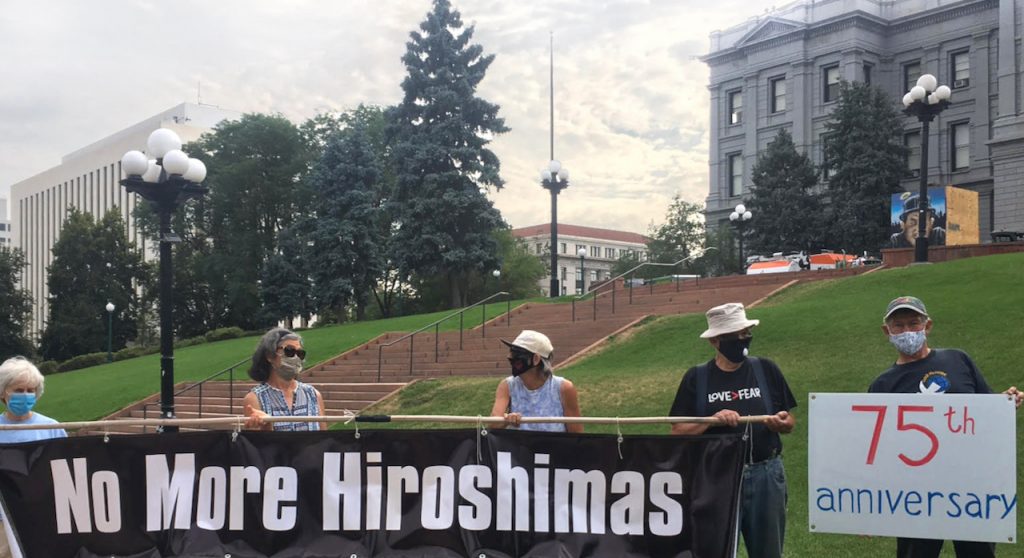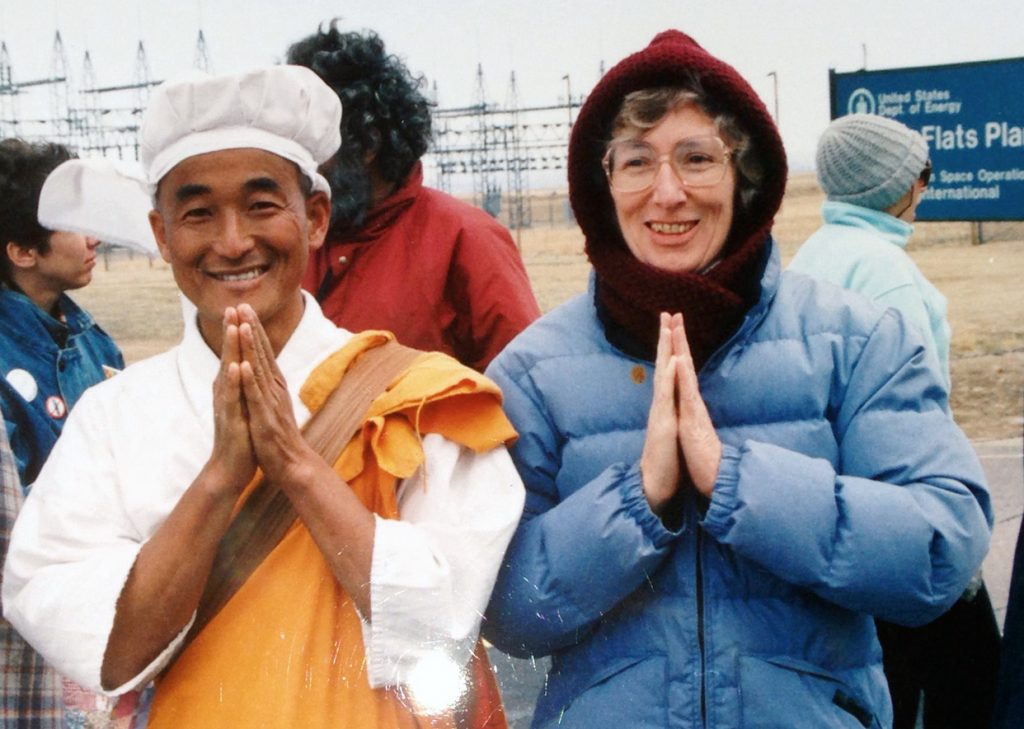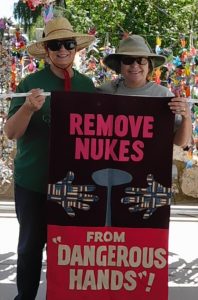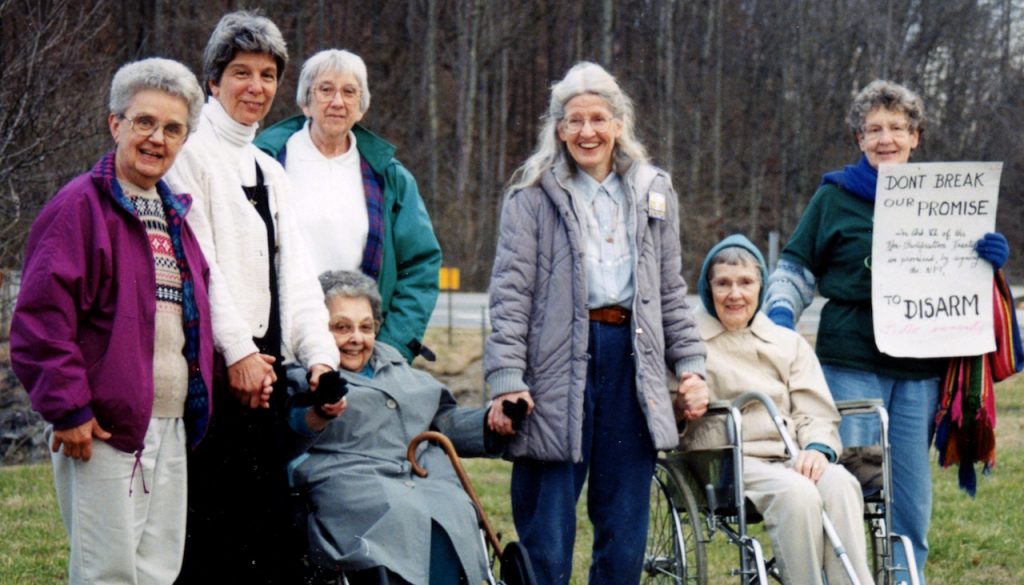Acting for peace across the U.S.
Posted on February 21, 2021, by Loretto Community
Colorado

Photo courtesy Byron Plumley CoL
Each Sunday for 12 years, Loretto Community members protested in rain, sleet, snow or shine at the Rocky Flats plant west of Denver (see photo, below). Plutonium triggers for nuclear weapons were manufactured at the plant that was run by Rockwell International until 1990.

Photo courtesy Byron Plumley CoL
The Loretto Community in Colorado was inspired by the work of three Dominican sisters, Ardeth Platte, Carol Gilbert and Jackie Hudson, who highlighted the presence of nuclear weapons at rural sites, primarily in the western U.S. Loretto Community members joined with the Dominican sisters to protest at a silo near New Raymer, Colo., one of the sites in the state even now holding an intercontinental ballistic missile prepared for launch.
Vigils for peace are now held in downtown Denver twice a week, and on Hiroshima Day each August (see photo at top).
In 1990, Loretto participated in a peace vigil at City Park in Denver at which lanterns made by school children were launched on the park’s lake. There are many ways to act for peace.
With thanks to Pat McCormick SL and Byron Plumley CoL
Missouri
Uranium processing to create the nuclear weapons dropped on Japan took place in St. Louis at Mallinckrodt Chemical on Second and Destrehan, near the Mississippi River. Debris from the process was trucked north and dumped at several sites, including Weldon Springs, Bridgeton and the future airport site and Latty Avenue. These radioactive dumping sites became known gradually over a 30-year period with the help and leadership of Catholic sisters, including Loretto sisters, and community resistance formed. The sites are marked now, and some have concrete caps, but all are still awaiting removal. The St. Louis protests and lobbying have focused on environmental remediation.
Mary Ann McGivern SL
The corporate headquarters of General Dynamics, McDonnell Douglas and Monsanto were in St. Louis. Loretto bought stock and Community members attended meetings starting in 1977 to challenge manufacture of nuclear material, guidance systems and planes and missiles designed to deliver these so-called smart bombs. (Loretto’s shareholder campaign, of course, also called for other corporations not based in Missouri like Rockwell, Martin Marietta, Grumman and Lockheed to change their practices.)
Loretto has protested at Whiteman Air Force Base, which is currently one of three nuclear bomber bases in the U.S. (The other bases are in North Dakota and Louisiana.)
Loretto members and friends protest and risk arrest at the Kansas City Plant, an anonymous-sounding name for the site that manufactures the bombs’ non-nuclear components.
With thanks to Mary Ann McGivern SL
New Mexico

Photo: Sandra Hareld CoL
Loretto Community members have been active in the state where the first nuclear bombs were tested. Los Alamos National Laboratory still researches and develops nuclear weapons and managed the country’s nuclear test site in Nevada until 1992.
Today, according to Mary Ann McGivern SL, “The nuclear weapon’s pit is manufactured at Los Alamos, using plutonium with a tritium reservoir. It is fissile fuel that explodes, acting as a trigger for the massive thermonuclear implosion.”
Penny McMullen SL, who died in 2017, lived in Santa Fe and for many years tracked the Department of Energy [DOE] management of the nuclear material at Los Alamos. She represented Loretto at hearings and helped others develop written testimony. When Los Alamos or the DOE requested permit changes, Penny helped explain the issues and write responses.

Loretto Community members have protested at New Mexico’s White Sands Missile Range, the Department of Defense site near where the world’s first nuclear weapons were tested; open-air missile tests are currently carried out here, as well as at sites managed by Sandia Laboratories, a branch of the Los Alamos Project owned by Honeywell (previously owned by Lockheed Martin) and co-located at Lawrence Livermore National Laboratory in California. Mary Ann was arrested while protesting at White Sands with Martin Sheen and Dom Hélder Câmara in the 1980s.
Loretto continues to join the Hiroshima Day vigils at Los Alamos each year in August. In the photo above, Trish Herron CoL holds a Loretto sign at an annual Sackcloth and Ashes Peace Vigil.
With thanks to Sandra Hareld CoL, Mary Ann McGivern SL and Karen Navarro CoL
Ohio
Mound City, Ohio, was the site of a plant making detonators and explosives for nuclear weapons until 1994. Originally located in Dayton, where the work carried out was an important part of the Manhattan Project, including production of polonium initiators used in the bombs dropped on Japan, the plant was moved to this location after World War II. Monsanto, based in St. Louis, managed the plant for the Atomic Energy Commission/Department of Energy (DOE). Nuclear tests were carried out at Mound City between 1948 and 1958.
Loretto, the Church of the Brethren and other faith groups that held Monsanto shares of stock filed resolutions every year for seven years calling on Monsanto to end its contract with the DOE because nuclear weapons are bad business and not in Monsanto’s best interest. The company did cancel its contract but did not admit that our resolutions (that year after year gained more than 10 percent of the vote) in any way impacted the purely business decision.
Tennessee
Oak Ridge, Tenn., is the site of the world’s oldest continually operating nuclear facility. The first uranium enrichment took place here. After World War II, it continued as a preeminent site for developing nuclear weapons; the site is still an active nuclear weapons facility producing and storing highly enriched uranium, among other activities. For many years, nuclear waste was injected deep into the ground at Oak Ridge, an environmental nightmare.

Photo: Loretto Archives
Washington, D.C.
Loretto participated in the 1985 event called, “The Ribbon,” commemorating the 40th anniversary of the Hiroshima and Nagasaki bombings. A 15-mile ribbon, made of 27,000 panels, was wrapped around the Pentagon. After wrapping the Pentagon, the ribbon ran along the the Jefferson Davis Highway and Washington Boulevard, crossed the Potomac River and then moved into Washington, D.C., and onto the National Mall before wrapping around the city block where the U.S. Capitol stands, past the Lincoln Memorial and returning across the Potomac to the Pentagon.
See the back cover of this issue for a historic photo of Loretto Community members with Loretto’s panels for “The Ribbon” event.
The United Nations
Loretto entered into a formal affiliation with the United Nations in the early 1990s. The Community is active on several committees and working groups, including the NGO Committee on Disarmament, Peace and Security.
Loretto attends treaty meetings that the U.N. holds every five years to assess compliance with nuclear treaties and has been involved with the current push to ratify the Treaty on the Prohibition of Nuclear Weapons, which went into force on Jan. 22 of this year. Beth Blissman CoL is Loretto’s U.N. NGO Representative.
Read the Loretto Magazine Winter 2021 issue in full here.
